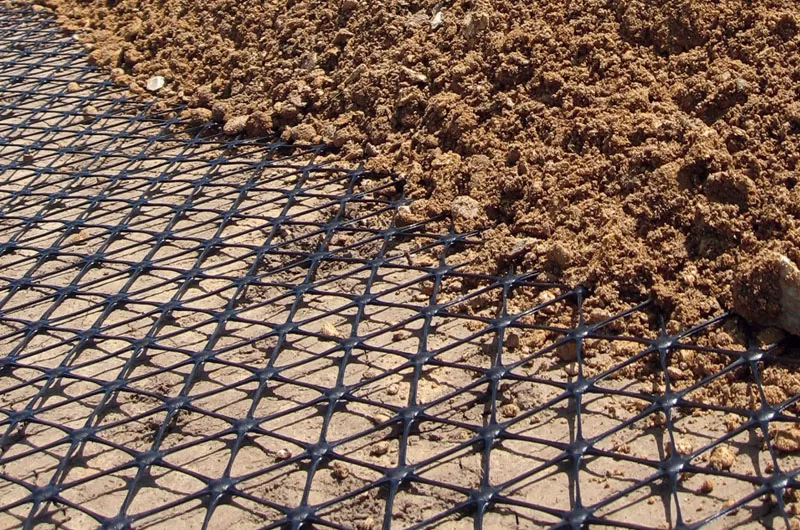+86-159 9860 6917
info@geofantex.com
geofantex@gmail.com
+86-400-8266163-44899
Geogrid fabrics are crucial in preventing structural failure by withstanding various forces across multiple applications. One common use is in driveway construction, where biaxial driveway geogrids help maintain the surface’s structural integrity and long-term stability. Evaluating a geogrid’s reliability involves assessing its junction integrity, which is determined by its ultimate junction strength—the maximum force a junction can withstand before breaking. Higher ultimate junction strength indicates better junction integrity. We also offer a heavy-duty woven separation fabric.
Ultimate Junction Strength
Definition: Ultimate Junction Strength (UJS) is the maximum stress a material’s junction or joint can withstand before failure. This concept is crucial in materials science and engineering as it determines the load-bearing capacity of interconnected materials or structures.
Measurement: UJS is typically measured through mechanical testing methods such as:
- Tensile Tests: To measure the maximum tensile stress the junction can handle.
- Shear Tests: To assess the shear strength of the junction.
- Compression Tests: To evaluate the compressive strength.
Specialized equipment like universal testing machines (UTM) are used to apply controlled loads and measure the resulting stresses and strains.
Factors Affecting UJS:
- Material Properties: The inherent strength, ductility, and toughness of the materials being joined.
- Junction Design: The geometric configuration and surface area of the junction.
- Joining Method: Techniques such as welding, soldering, adhesive bonding, or mechanical fastening.
- Environmental Conditions: Temperature, humidity, and exposure to corrosive elements.
- Load Conditions: Type, magnitude, and direction of applied loads.
Importance: Understanding UJS is vital for ensuring the reliability and safety of structures and products. It helps in:
- Design Optimization: Creating robust joints that can handle expected loads without failure.
- Material Selection: Choosing appropriate materials and joining methods for specific applications.
- Safety Assurance: Preventing catastrophic failures in critical applications such as aerospace, automotive, and construction.
Real-World Applications:
- Aerospace Engineering: Ensuring the integrity of joints in aircraft structures subjected to extreme conditions.
- Automotive Industry: Designing strong and durable joints in car frames and body panels.
- Construction: Creating reliable connections in steel frameworks and concrete structures.
- Electronics: Ensuring the durability of solder joints in circuit boards and microelectronic devices.
Ultimate Junction Strength is a key parameter in materials science and engineering that influences the overall performance and safety of various products and structures. Accurate measurement and consideration of factors affecting UJS are essential for successful design and application in numerous fields.

Triaxial Geogrids
Characteristics of Triaxial Geogrids
- Structure: Triaxial geogrids are made from polypropylene or polyethylene and consist of triangular apertures arranged in a hexagonal pattern.
- Strength: They have high tensile strength and stiffness in all directions, providing uniform load distribution.
- Durability: Resistant to chemical and biological degradation, making them suitable for long-term applications.
Uses of Triaxial Geogrids
- Soil Stabilization: Used to reinforce and stabilize weak soils in roadways, railways, and embankments.
- Base Reinforcement: Applied in the construction of paved and unpaved roads to improve load-bearing capacity.
- Slope Protection: Helps in preventing soil erosion and maintaining slope stability.
- Retaining Walls: Used in the construction of retaining walls to enhance their structural integrity.
Benefits of Triaxial Geogrids
- Load Distribution: Offers superior load distribution due to its unique triangular structure.
- Cost-Effective: Reduces the need for excavation and use of high-quality fill material, lowering overall project costs.
- Ease of Installation: Lightweight and easy to handle, which speeds up construction processes.
- Environmental Impact: Minimizes the environmental footprint by reducing the need for additional materials and resources.
Biaxial Geogrids
Biaxial geogrids are geosynthetic materials formed into a grid with integrally connected tensile elements and apertures large enough to allow “strike-through” and interlocking with surrounding aggregate base materials, commonly rock. They increase the stiffness of unbound aggregate base layers and confine aggregate particles under repetitive loading.
Characteristics of Biaxial Geogrids
- Made from punched and drawn polypropylene material.
- Must comply with Caltrans’ Standard Specifications for Biaxial Geogrids.
- Placed below or within the aggregate base layer of pavement structures.
- The composite section of the geogrid and aggregate base is known as a mechanically stabilized layer (MSL).
Benefits of Biaxial Geogrids
- Reduced aggregate base thickness, leading to cost savings.
- Enhanced performance life and reliability of the pavement.
- Improved compaction and uniformity over soft or variable soils.
- Reduced hauling and heavy construction traffic due to fewer materials needed for removal, replacement, or backfill.
- Ability to install in a wide range of weather conditions.
- Improved safety from reduced construction time and less hauling and processing of subgrade or backfill materials.
Appropriate Applications
Biaxial geogrids are suitable for asphalt or gravel (flexible) surfaces but do not offer benefits under concrete pavement. They are most cost-effective in areas where pavement surface grade and drainage dictate the pavement structural section. Appropriate applications include:
- Restricted Pavement Surface Grades: When local drainage or vertical clearance restricts surface grades, a biaxial geogrid can provide a thinner section with equivalent performance to a thicker aggregate base.
- Expedited Construction: A thinner biaxial geogrid section results in less construction time and material requirements, often requiring less compaction effort.
- Increased Pavement Structural Capacity: Provides increased structural capacity and performance life for the same thickness of pavement without biaxial geogrid.
- Soft or Weak Subgrades: Reduces or eliminates the need for material removal.
Get Free Sample
We’ll respond as soon as possible(within 12 hours)






















